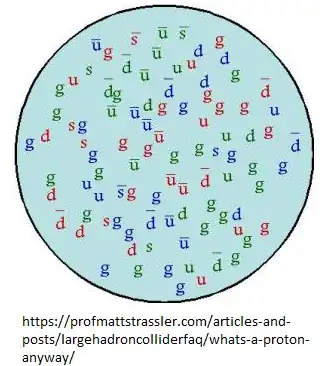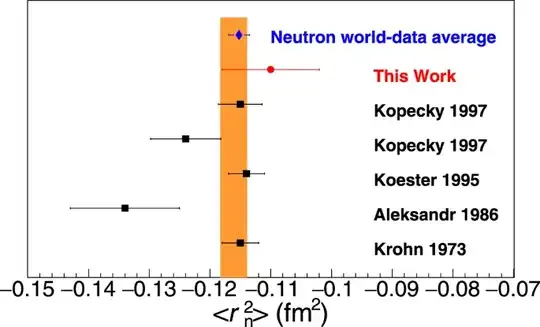The radius of a proton is described as a "charge radius", about 0.84 fm. The neutron is about the same size, 0.8 fm, but has no measureable charge. Is this a contradiction? Are the two radii measured in the same way?
2 Answers
The neutron is a quantum mechanical entity, and as well as the proton it is a complex bound state of valence quarks and a sea of virtual quark antiquark and gluons, similar to the proton picture.
Quarks and antiquarks are charged and so a scattering of electrons on neutrons should show up a radius due to the charged constituents making up the neutron. This is a difficult experiment as neutrons decay and cannot be stationary targets as the proton. Methods have been devised to extract the radius, as explained in the publication below:
From Atac et al. (2021) abstract :
Despite the neutron zero-net electric charge, the asymmetric distribution of the positively- (up) and negatively-charged (down) quarks, a result of the complex quark-gluon dynamics, lead to a negative value for its squared charge radius, ${r_n}^2$.
The measurement from this work (red circle), with the error bar corresponding to the total uncertainty at the 1σ or 68% confidence level, and from references3,4,5,6 (black box) included in the PDG analysis for the radius. The orange-band indicates the PDG averaged value. The new weighted average of the world data is also shown (blue diamond) when the new measurement reported in this work is included in the calculation.
They give old and new measurements of the neutron charged radius
see link for details of calculations.
Charge radii are an open research project both theoretically and experimentally.
- 236,935
Netrons have no net charge the same way a neutral hydrogen atom has no net charge. I don't know what the electric charge profile of a neutron looks like, but it's going to be rather complicated. See the parton distribution for hadrons - it describes how much each particle type contributes at each length scale.
At a guess, though, the neutron will have more positive charge at the center and more negative toward its outside. This is because it's more electromagnetically stable when you have one negative valence particle (the up quark) and two negative ones (the down quarks). I would expect it to be similar for protons - more positive charge toward the outside, less toward the center (possibly even going negative at the very center). This is all wild speculation, though, so take it with a fist sized lump of salt.
- 22,927

